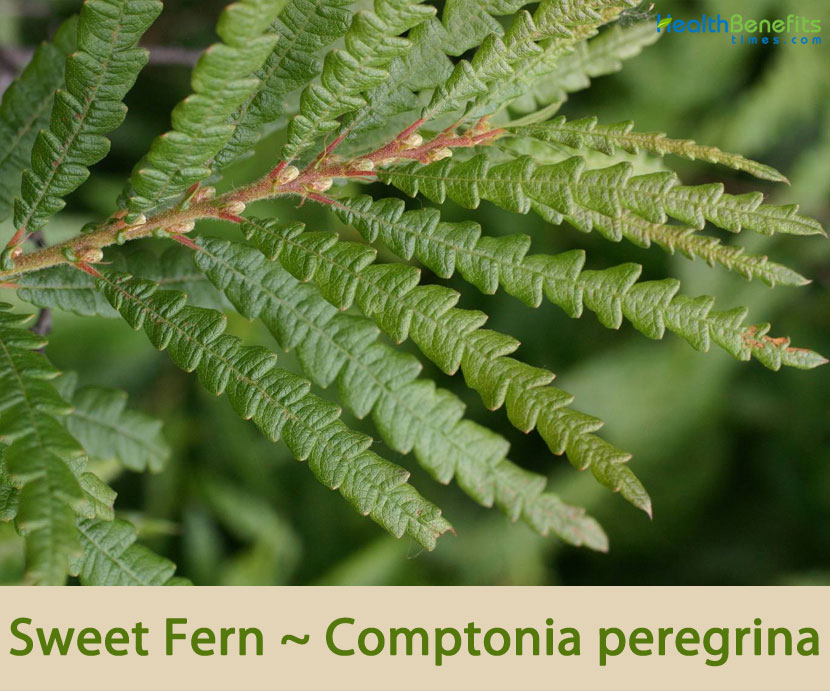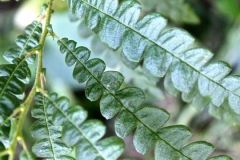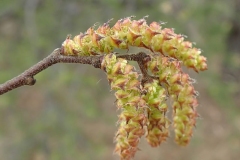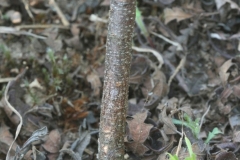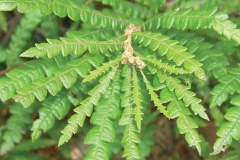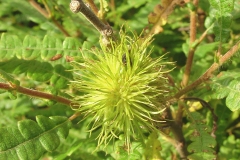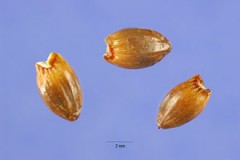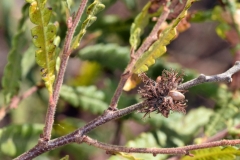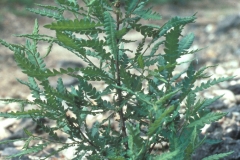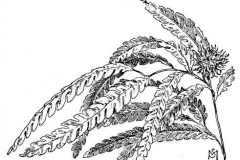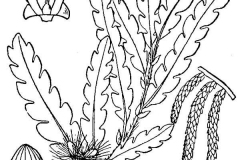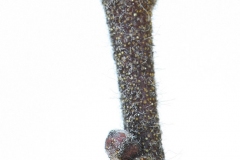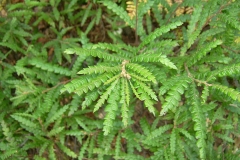| Sweet Fern Quick Facts | |
|---|---|
| Name: | Sweet Fern |
| Scientific Name: | Comptonia peregrina |
| Origin | Eastern North America, from Ontario and Quebec in the north |
| Colors | Brown |
| Shapes | Round cluster of ovoid brown 1/4 inch long shiny nutlets |
| Taste | Slightly resinous taste |
| Health benefits | Daarrhea, headache, fevers, catarrh, vomiting of blood, rheumatism, toothaches, sprains, minor hemorrhages, dysentery and ringworm |
| Name | Sweet Fern |
|---|---|
| Scientific Name | Comptonia peregrina |
| Native | Eastern North America, from Ontario and Quebec in the north, east to Nova Scotia, south to the extreme north of Georgia, and west to Minnesota |
| Common Names | Ferngale, fern bush, meadow fern, shrubby fern, Canada sweetgale, spleenwort bush, sweet bush, sweet ferry, Sugar fern |
| Name in Other Languages | Croatian: Komptonija Czech: Postopčák cizí Danish: Almindelig Bregnepors English: Sweet fern, Fern-gale, Sugar fern Finnish: Tuoksumyrtti French: Comptonie, Comptonie voyageuse, Comptonie à feuilles d’asplénie German: Farnmyrte Italian: Comptonie Ojibwa: Gibaime’nûagwûs, gibaime’nûna’gwûs, kba’ange-minš Polish: Komptonia amerykańska Swedish: Bräkenpors |
| Plant Growth Habit | Small, low, aromatic, monoecious or dioecious mound-shaped rhizomatous shrub |
| Growing Climates | Dry piney woods, exposed mountain slopes, abandoned pastures, clearings, barrens, highway embankments, gravel pits, weathered mine tailings, cut-over forested land, dry, sterile, sandy to rocky soils in pinelands or pine barrens, road sides, open wood lots and meadows |
| Soil | Grows well in dry, sterile, sandy soils, from well-drained dry sites to the edges of marshes |
| Plant Size | 0.5 to 1.5 m tall and 1.2 to 2.5 m wide or more |
| Shoot | Young shoots are light green to light brown, terete, and very pubescent, becoming less pubescent with age |
| Twigs | Slender, gray-brown, fuzzy; buds round, plump, male catkins present in the winter, resin dots often present |
| Bark | Gray or reddish brown, more or less smooth, and terete with scattered white lenticels |
| Stem | Stems are green, yellowish, or reddish-brown when young, turning reddish-purple or coppery-brown with age |
| Leaf | Linear to lanceolate, 3–15 cm (1.2–5.9 in) long and 0.3–3 cm (0.1–1.2 in) broad, with a lobed margin; they give off a sweet odor, especially when crushed |
| Buds | Buds are globular, minute, solitary, and sessile, with two to four exposed scales |
| Flowering season | March to April |
| Flower | Plants are monoecious with separate unisexual flowers. The staminate flowers grow in clusters at the ends of branches, and are up to 5 cm (2.0 in) long. The pistillate flowers are only 5 mm (0.2 in), but elongate when the fruits form, reaching 5 cm (2.0 in) |
| Fruit Shape & Size | Round cluster of ovoid brown 1/4 inch long shiny nutlets |
| Fruit Color | Brown |
| Flavor/Aroma | Spicy, aromatic odor |
| Taste | Slightly resinous taste |
| Plant Parts Used | entire plant, especially the leaves and tops |
Plant Description
Sweet Fern is a small, low, aromatic, monoecious or dioecious, mound-shaped rhizomatous shrub that normally grows about 0.5 to 1.5 m tall and 1.2 to 2.5 m wide or more. The plant is found growing in dry piney woods, exposed mountain slopes, abandoned pastures, clearings, barrens, highway embankments, gravel pits, weathered mine tailings, cut-over forested land, dry, sterile, sandy to rocky soils in pinelands or pine barrens, road sides, open wood lots and meadows. The plant grows well in dry, sterile, sandy soils, from well-drained dry sites to the edges of marshes. Young shoots are light green to light brown, terete, and very pubescent, becoming less pubescent with age. Bark is gray or reddish brown, more or less smooth, and terete with scattered white lenticels. Buds are round, plump, male catkins present in the winter, resin dots often present.
Leaves and Stem
Leaves are simple and alternate, the blades are linear-oblong or lance-linear, 1¼ to 5 inches long, 1/3 to ¾ inch wide, the base and tip sometimes blunt or tapered to a sharp point, short-stalked or stalkless. The edges are toothless but fern-like with deep, rounded to squarish lobes with blunt or pointed tips. The upper surface is dark green, hairy or becoming smooth, lower surface pale green, hairy or becoming smooth. Both surfaces are heavily dotted in yellow glands. At the base of the leaf are pair of leafy appendages (stipules) that are somewhat heart-shaped with a long taper to a sharply pointed tip. Fall color can be nice reddish before turning brown.
Twigs are very fine, brown to reddish or purplish, gland dotted, hairy with a few scattered lenticels (pores). Stems are much branched above, the tips lacking a terminal bud. Lower stems are up to around 1/3 inch diameter with smooth, reddish-brown to gray bark.
Flower
Male and female flowers are borne separately on the same plant (monoecious) or different plants (dioecious) that are arranged in greenish catkins toward the tips of twigs or young shoots; flowering occurs before leaves emerge. Male catkins are drooping and cylindrical, ½ to 1¼ inches long, single from lateral buds, mostly crowded at tips of one-year-old twigs, with 25 to 50 flowers each with a sharply pointed scale-like bract. Each male floret has 4-8 stamens on short filaments; it is partially hidden by a small scale (about 2-3 mm. in length) that is broadly ovate and ciliate along its margins.
The female catkins are about ½” long and ovoid to globoid in shape, consisting of a small cluster of female florets and their scales. Each female floret has a naked ovary with a pair of stigmata at its apex; it is partially hidden by a small scale (about 2-3 mm. in length) that is broadly ovate and ciliate along its margins. In addition to this scale, there is a pair of linear bractlets that originate from the base of the ovary; they are up to twice the length of the scale. The blooming period occurs from mid- to late spring as the vernal leaves begin to develop, lasting about 2 weeks.
Fruit
Afterwards, the pollinated female catkins are replaced by round cluster of ovoid brown 1/4 inch long shiny nutlets in August, which mature in September and October. The average number of nutlets per fertilized catkin is 5.5 +. At maturity, individual nutlets are 3-5 mm. long, ovoid in shape, truncate-dentate on one side, and rounded on the other. Seeds require breaking of dormancy to germinate (usually by cold stratification or by planting outside in fall) and usually remain in the soil for some time – they are known to be viable for up to 70 years when they remain in the soil.
Traditional uses and benefits of Sweet Fern
- Sweet fern was used medicinally by several native North American Indian tribes who used it especially as a poultice to treat a variety of complaints.
- It is still used for most of the same purposes in modern herbalism.
- Leaves are astringent, blood purifier, expectorant and tonic.
- Tea made from the leaves and flowering tops is used as a remedy for diarrhea, headache, fevers, catarrh, vomiting of blood, rheumatism etc.
- The infusion has also been used to treat ringworm.
- Leaves have also been used as a poultice for toothaches, sprains etc.
- Cold water infusion of the leaves has been used externally to counter the effect of poison ivy and to bathe stings, minor hemorrhages etc.
- Leaves are harvested in early summer and dried for later use.
- Tea made from the leaves has been used to relieve symptoms of dysentery.
Culinary uses
- Young fruits are eaten as a pleasant nibble.
- Aromatic leaves, fresh or dried, are used to make a palatable tea.
- The leaves are also used as a seasoning.
- Leaves are used for potpourri.
Other Facts
- Leaves are used as a lining in baskets etc. in order to preserve the fruit.
- The crushed leaves repel insects.
- They can be thrown onto a camp fire to keep mosquitoes away.
- The dried leaves have been burnt as incense.
- Fern-like leaves and stems that are aromatic when crushed.
References:
https://www.itis.gov/servlet/SingleRpt/SingleRpt?search_topic=TSN&search_value=501619#null
https://pfaf.org/user/Plant.aspx?LatinName=Comptonia+peregrina
http://www.missouribotanicalgarden.org/PlantFinder/PlantFinderDetails.aspx?kempercode=c240
https://en.wikipedia.org/wiki/Comptonia_peregrina
https://www.wildflower.org/plants/result.php?id_plant=cope80
https://plants.usda.gov/core/profile?symbol=COPE80
https://www.fs.fed.us/database/feis/plants/shrub/comper/all.html
https://www.cabi.org/isc/datasheet/15640
https://www.nrs.fs.fed.us/pubs/jrnl/2004/nc_2004_pijut_002.pdf
https://gobotany.nativeplanttrust.org/species/comptonia/peregrina/
http://www.theplantlist.org/tpl1.1/record/kew-2733828
https://hort.purdue.edu/newcrop/HerbHunters/sweetfern.html
https://gd.eppo.int/taxon/COVPE
https://www.illinoiswildflowers.info/savanna/plants/sweet_fern.html


